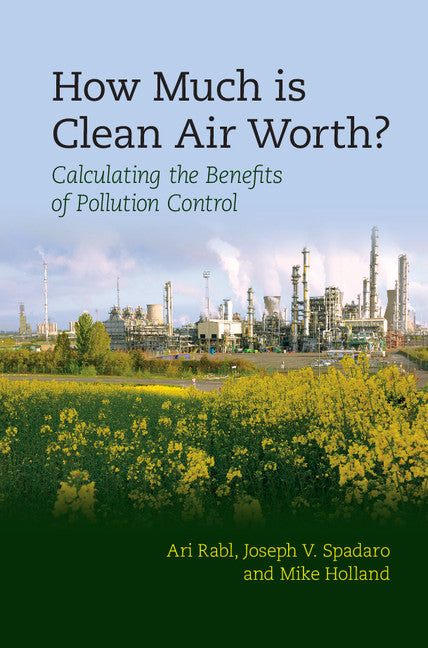Freshly Printed - allow 8 days lead
Couldn't load pickup availability
How Much Is Clean Air Worth?
Calculating the Benefits of Pollution Control
A comprehensive reference on the main methodologies used to calculate the benefits of pollution control, with worked examples.
Ari Rabl (Author), Joseph V. Spadaro (Author), Mike Holland (Author)
9781107043138, Cambridge University Press
Hardback, published 10 July 2014
695 pages, 135 b/w illus. 98 tables
23.6 x 15.7 x 3.5 cm, 1.25 kg
'Ari Rabl and his co-authors have successfully tackled an extremely difficult subject, the estimation of damage costs associated with environmental pollution. Decisions regarding what level of environmental quality to provide are both vital and unavoidable (the decision to do nothing is itself a decision, with benefits and costs). With this volume to guide them, decision-makers will be virtually certain to make better decisions in this important area than would be the case in the absence of the information the authors provide. State-of-the-art methodologies are clarified with the aid of numerous important examples, hence anyone with a serious interest in the environment will benefit enormously from this book.' Philip E. Graves, University of Colorado
How Much Is Clean Air Worth? offers readers a comprehensive overview of the core methodologies and tools used to quantify the impacts and damage costs of pollution. The book begins by reviewing the tools used for environmental assessments and shows that a rational approach requires an impact pathway analysis (IPA) for each of the possible impacts of a pollutant, i.e. an analysis of the chain emission -> dispersion -> exposure-response functions -> monetary valuation. The IPA methodology is explained in full and illustrated with worked examples, and difficulties are discussed and uncertainties analysed. In addition to detailed computer models, a very simple model (the 'Uniform World Model') is presented, enabling readers to make estimates for cases where no results are available. Published results for electricity, waste treatment and transport are reviewed, with a thorough discussion of policy implications. This book will appeal to a broad mix of academics, graduate students and practitioners in government and industry working on cost-benefit analysis, environmental impact analysis and environmental policy.
Foreword
Preface
Acknowledgements
1. Introduction
2. Tools for environmental impact and damage assessment
3. Exposure-response functions for health impacts
4. Impacts of air pollution on building materials
5. Agriculture, forests and ecosystems
6. Other impacts
7. Atmospheric dispersion of pollutants
8. Multimedia pathways
9. Monetary valuation
10. The costs of climate change
11. Uncertainty of damage costs
12. Key assumptions and results for cost per kg of pollutant
13. Results for power plants
14. Results for waste treatment
15. Results for transport
16. Lessons for policy makers
Appendix A. Nomenclature, symbols, units and conversion factors
Appendix B. Description of the RiskPoll software
Appendix C. Equations for multimedia model of Chapter 5
Index.
Subject Areas: Pollution control [TQK], Earth sciences [RB], Environmental economics [KCN], Economics [KC]


